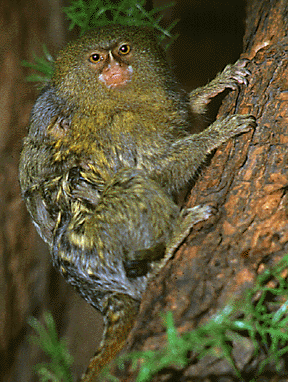PYGMY MARMOSET
Callithrix pygmaea
MAMMAL
Order Primata
Description
One of the smallest living monkeys;
at the lower end of the
marmoset/tamarin size range: head + body 7-12 in; tail 8-16 in; weight 1/3-1/2
lb. Tawny brown, long hairs of head and cheeks form a mane; tail ringed
with darker brown. Claws rather than nails on digits. Marmosets are specialized
sap and gum eaters, and differ from tamarins in having longer incisor and
shorter canine teeth.
Range
upper Amazon basin in Colombia, Peru, Ecuador, Bolivia, and Brazil.
Status
Habitat conversion for farms and logging/mining are threats. This species is locally/regionally vulnerable.
Photo © James P. Rowan Photography

 Ecology
Ecology
- Habitat
- Highest part of canopy in tropical rain forest trees; populations are highest in riverside or seasonally flooded forest, especially along the forest edges.
- Niche
- Feeds primarily on tree sap and gum, but also eats spiders, insects, bird eggs, lizards, fruit and buds. Diurnal, vocal, usually found in extended family groups. Home range 0.5-1.0 acres, depending upon food supply. Range marking includes urine scent marking, bird-like calls, genital display, and, when necessary, chasing intruders.
Life History
Usually only one female in the extended family breeds. Gestation about 5 months; male parent and other group members assist in carrying the two young, transferring them to the mother at feeding time. Once the young can eat food items, group members will also surrender food to them. Young ride on adults' backs until 6-7 weeks, gradually increasing time spent away from security of an adult. Maturity occurs at 18-24 months.
Special Adaptations
- Long incisor teeth and reduced canine teeth designed for gouging holes in tree bark to get at sap or gum.
- Claws help keep foothold on tree branches as the monkey runs along the branch surface.
- Small size allows animal to hide in foliage or in tree hollows when danger threatens.
- Extended family groups help youngsters to learn
how to raise offspring.
